Physical Address
304 North Cardinal St.
Dorchester Center, MA 02124
Preterm birth is the principal unsolved problem in perinatal medicine. The rate of preterm birth in the United States has been rising since 2015 to 10.23% in 2019. Advances in care have improved outcomes for preterm infants, but prematurity is still the most common underlying cause of perinatal and infant morbidity and mortality in developed nations. Consequences of preterm birth for surviving infants extend across the life course and include neurodevelopmental, respiratory, gastrointestinal, and other morbidities.
Classifications of preterm birth may advance biologic understanding, define clinical phenotypes, and aid in designing trials and interpreting their data. The most used categories are based on clinical presentation as either a spontaneous or an indicated preterm birth. Spontaneous preterm births are preceded by activation of one or more steps of the parturition process: cervical ripening, membrane and decidual activation, and coordinated uterine contractility (see Chapter 7 ). Clinical presentations of spontaneous preterm delivery include preterm labor with intact membranes, preterm prelabor rupture of membranes (pPROM), preterm cervical effacement or insufficiency, and some instances of uterine bleeding of uncertain origin, including abruption. Indicated preterm births are medically caused or initiated and are actively undertaken in response to maternal or fetal compromise. This categorization scheme has fallen under scrutiny in recent years. In this chapter, we address some limitations to this approach and alternative classification systems that reflect a modern understanding of clinical presentation and biology. The physiology and pathophysiology of term and preterm parturition are discussed in Chapter 6, Chapter 7 , respectively. This chapter addresses the overall problem of preterm birth, including the epidemiology and burden of disease for all preterm neonates and specific care for the clinical syndrome of preterm labor. Prelabor rupture of the fetal membranes and stillbirth are discussed in Chapter 39, Chapter 42 , respectively. Newborn and childhood complications of preterm birth are discussed in Chapter 73 .
A birth at less than 245 days after conception (with good gestational dating criteria), or between 20 0/7 and 36 6/7 weeks’ gestation (259 days) as estimated by last menstrual period and/or ultrasound, is commonly defined as preterm or premature. Births at or after 37 0/7 weeks are considered to be term, nomenclature that has been recently revisited to reflect fetal maturity: 37 0/7 to 38 6/7 early term and 39 0/7 to 40 6/7 full term. Infants who weigh less than 2500 g at birth, regardless of gestational age, are designated as low birth weight (LBW). Infants who weigh less than 1500 g are called very low birth weight (VLBW), and those below 1000 g are extremely low birth weight. Preterm and LBW infants have in the past been considered together, but advances in the accuracy of pregnancy dating increasingly allow outcomes related to gestational age to be distinguished from outcomes related to birth weight. This is important, because perinatal and infant morbidities vary substantially according to age and maturity as well as weight. Obstetric data are reported by gestational age. Traditionally reported by birth weight, newborn and infant data are increasingly described by gestational age as well.
The lower and upper boundaries of “preterm” are subjective. The lower boundary between preterm birth and spontaneous abortion was historically predicated on maternal perception of fetal movement, and commonly defined as 20 weeks’ gestation in the United States, but it varies among states and countries. The 20-week boundary has been challenged by data showing that pregnancies ending between 16 and 20 weeks have a pathophysiology similar to births at 20 to 26 weeks, and that that pathophysiology confers a similarly increased risk for recurrent preterm birth between 16 and 36 weeks, regardless of whether the fetus was liveborn or stillborn. ,
Similarly, the disadvantages of an upper boundary based on age rather than maturity have become increasingly apparent. Fetal and neonatal maturation are not complete at 37 weeks’ gestation. Infants born at 37 and even 38 weeks display clinical features of immaturity more commonly than those born at 39 weeks, and they often suffer related short- and long-term morbidity. , Current practice acknowledges the less-than-complete maturity of 37- to 38-week infants by adoption of the categories shown in Table 38.1 .
| Description | Gestational Age (wk) |
|---|---|
| Preterm | <37 |
| Late preterm | 34 0/7 to 36 6/7 |
| Term | 37 0/7 to 41 6/7 |
| Early term | 37 0/7 to 38 6/7 |
| Full term | 39 0/7 to 40 6/7 |
| Late term | 41 0/7 to 41 6/7 |
| Post term | ≥42 |
Preterm birth has been called multifactorial because of the numerous obstetric and medical conditions that accompany it. Traditional obstetric taxonomy has not distinguished the clinical presentations of preterm parturition (e.g., preterm labor, pPROM, cervical insufficiency) from causative mechanisms such as infection, hemorrhage, uterine distention, trauma, or fetal compromise, or from risk factors (e.g., multiple gestation, prior preterm birth, preeclampsia, abruptio placentae, placenta previa, fetal growth restriction, maternal diabetes, hypertension, pyelonephritis). Designation of clinical presentations (e.g., preterm labor and pPROM) as separate pathogenic entities has also impaired understanding of pathways promoting preterm birth. Thus it useful to consider preterm birth as a preterm pathologic initiation of one or more steps in the parturition process.
The concept of spontaneous versus indicated preterm birth offered by Meis and colleagues is consistent with this distinction. Indicated preterm births account for about 25% of preterm births in the United States, and follow medical or obstetric conditions that could create undue risk for the mother (e.g., maternal sepsis, hypoxia), the fetus (e.g., poorly controlled maternal diabetes, fetal growth restriction), or both (e.g., maternal hypertension, placenta previa or abruption) if the pregnancy were to continue. The most common diagnoses leading to indicated preterm birth are preeclampsia (25%–40%), abnormal fetal status (25%), fetal growth restriction (10%–20%), placental abruption (7%–10%), and stillbirth (7%). Other common causes and contributors include pregestational and gestational diabetes, renal disease, Rh sensitization, and congenital malformations. ,
Spontaneous preterm births may appear as preterm labor, pPROM, or related diagnoses when parturition begins in the apparent absence of maternal or fetal illness. Risk factors associated with spontaneous preterm birth include genital tract colonization and infection, non-White race, multiple gestation, bleeding in the second trimester, low prepregnancy weight/BMI, and a history of previous spontaneous preterm birth. Approximately 75% of preterm births in developed countries are spontaneous. , , While the distinction between indicated and spontaneous preterm births is not always clear, terms are useful as a framework for evaluation of trends and causes of preterm delivery.
Births before 37 weeks in the United States reached a nadir at 9.6% in 2014 and have been rising since then to 10.23% in 2019 ( Fig. 38.1 ). The reason behind the decrease in preterm birth in the early part of the decade is likely multifactorial. Gestational age is now calculated by the Centers for Disease Control and Prevention (CDC) birth data analysts based on best obstetric estimate based on ultrasound and last menstrual period. Additionally, there is the net effect of reduced teenage birth rate, lower tobacco use, fewer higher order multiple births, and efforts to reduce elective preterm birth versus potential increases in indicated preterm births due to maternal medical conditions relating to advanced maternal age or rising BMI. , It is unclear what effect interventions such as 17α-hydroxyprogesterone caproate (17-OHPC), vaginal progesterone, and the use of cerclage in selected populations have had on national preterm birth rates. ,
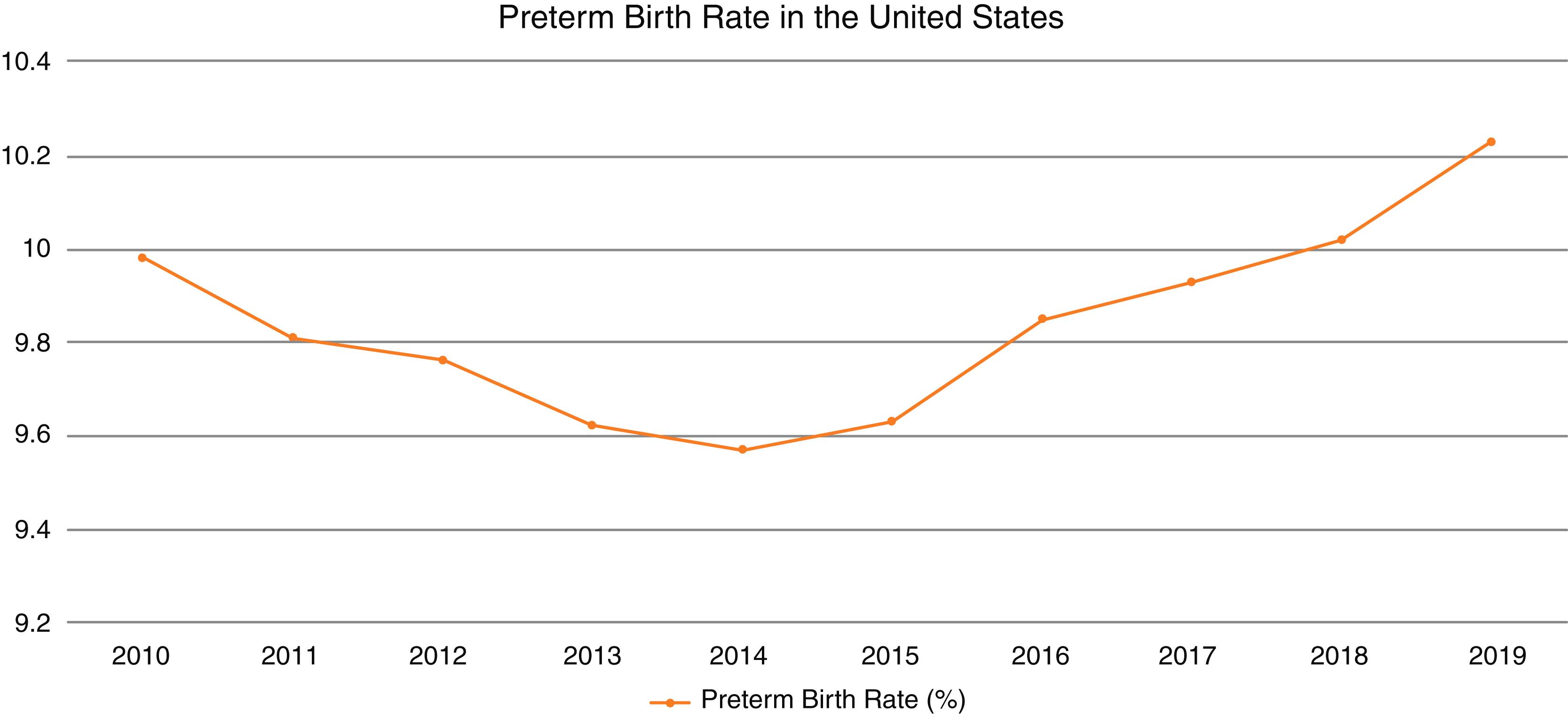
More than 70% of preterm births occur between 34 and 36 weeks’ gestation ( Fig.38.2 . Although these late preterm infants experience significant morbidity, most perinatal mortality and serious morbidity occur among the 16% of preterm infants (<3.5% of all births) who are born before 32 weeks’ gestation, commonly called early preterm births (see Fig. 38.7 ). More than half (52%) of all infant mortality occurs among infants born before 32 weeks’ gestation.
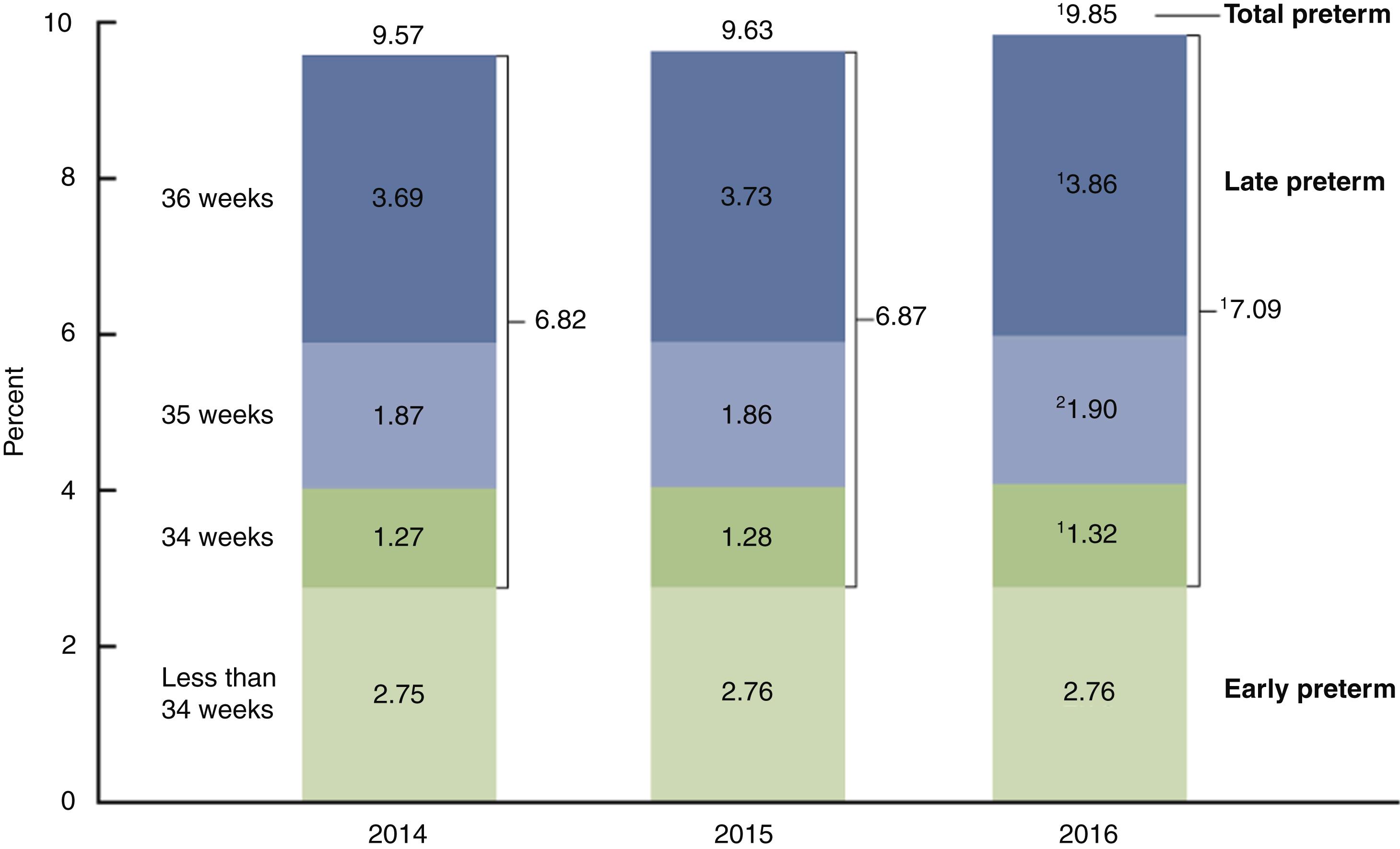
Regardless of the definitions chosen and methods used to determine gestational age, the incidence of preterm birth increased in developed countries between 1990 and 2006. The rise was caused by the rising number of multifetal pregnancies resulting from assisted reproductive technology (ART) and by practice changes favoring delivery over expectant management in the care of complicated late preterm singleton births. Prior to the nadir in 2014, the US preterm birth rate rose in singleton pregnancies from 7.3% in 1990 to 9.2% in 2006, when it began to decline through 2014 as perinatal and infant morbidities associated with late preterm birth were recognized and reported. Interestingly, while the preterm birth rate has been rising since 2014, the incidence of twins has been declining ( Figs. 38.3, 38.4 ). The frequency of higher order multifetal gestations has also declined significantly since 1998, but primarily in non-Hispanic White women ( Fig. 38.4 ). , In 2017, the American Society for Reproductive Medicine issued recommendations to achieve successful pregnancies while reducing the risk for preterm birth ( Box 38.1 ). Thus, as noted above, recent increases in preterm birth rates are largely attributable to increase in late preterm births (34–36 weeks).
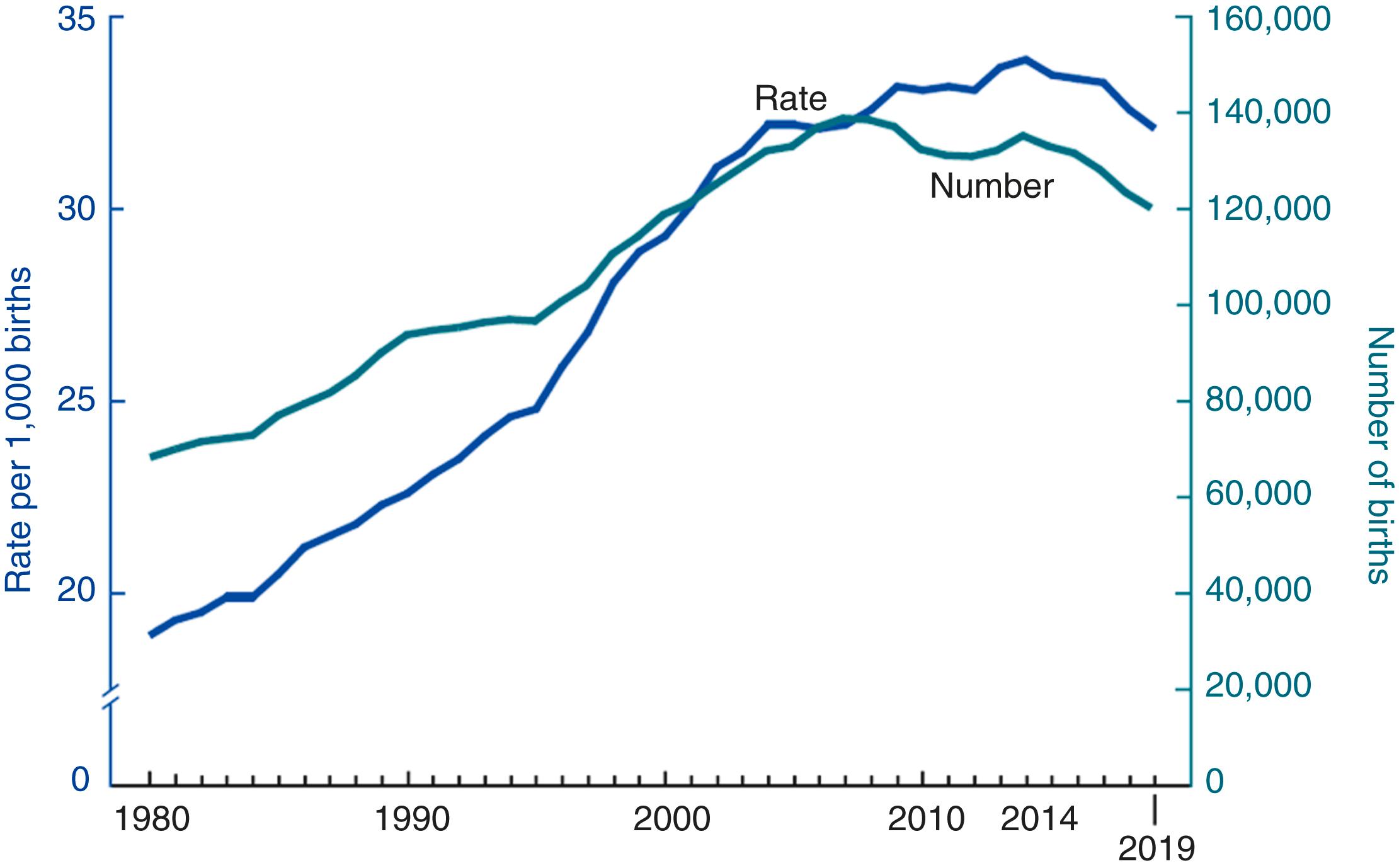
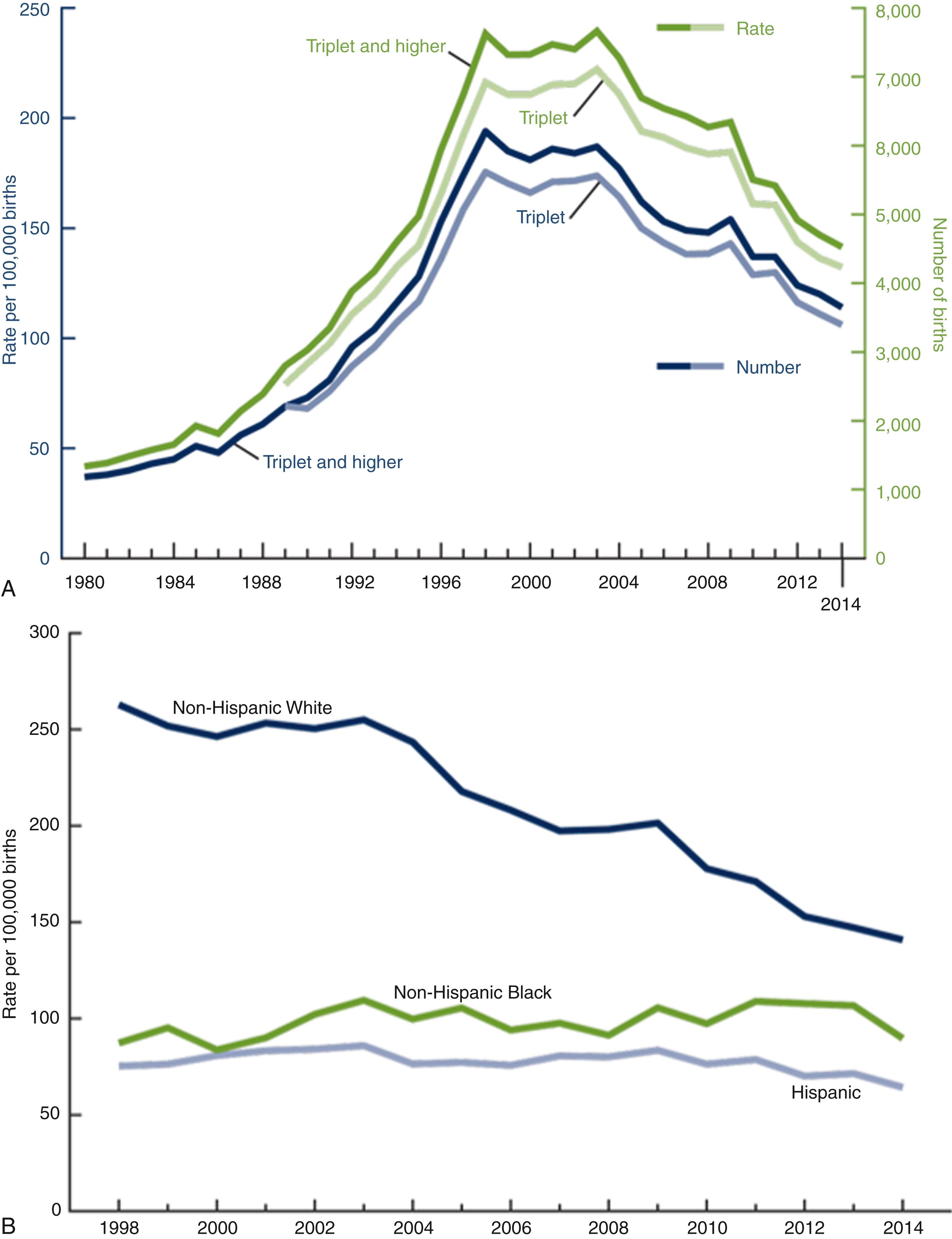
Use of single-embryo transfer in in vitro fertilization (IVF) cycles to reduce twinning
Use of low-dosage gonadotropins in ovulation induction insemination cycles
Moving from low-dosage ovulation induction drugs directly to IVF cycles rather than to higher-dosage induction cycles
Extensive education and counseling on the risks of multifetal pregnancies and prematurity for families, professionals, and the public
(See also Chapter 73 .)
Preterm birth is the leading cause of perinatal and infant mortality for infants born to women of all races and ethnic backgrounds, and particularly for non-Hispanic Black women. ,
The perinatal mortality ratio is defined in two ways according to the boundaries of the fetal and neonatal data reported. Perinatal definition I begins with fetal deaths at 28 weeks’ gestation and extends to infant deaths at less than age 7 days. Perinatal definition II is more inclusive, comprising all fetal deaths at 20 weeks’ gestation or more, and all infant deaths less than age 28 days. The denominators for both perinatal rate computations are per 1000 live births and fetal deaths for their respective time periods.
Perinatal definition I is most useful when data are compared between states, whereas definition II more accurately represents the combined effects of prenatal, intrapartum, and neonatal care. The infant mortality rate is the number of deaths of liveborn infants before the first year of age per 1000 live births; stillbirths are not included in the denominator. Rates of fetal, perinatal, and infant mortalities have declined since 1990 ( Fig. 38.5 ).
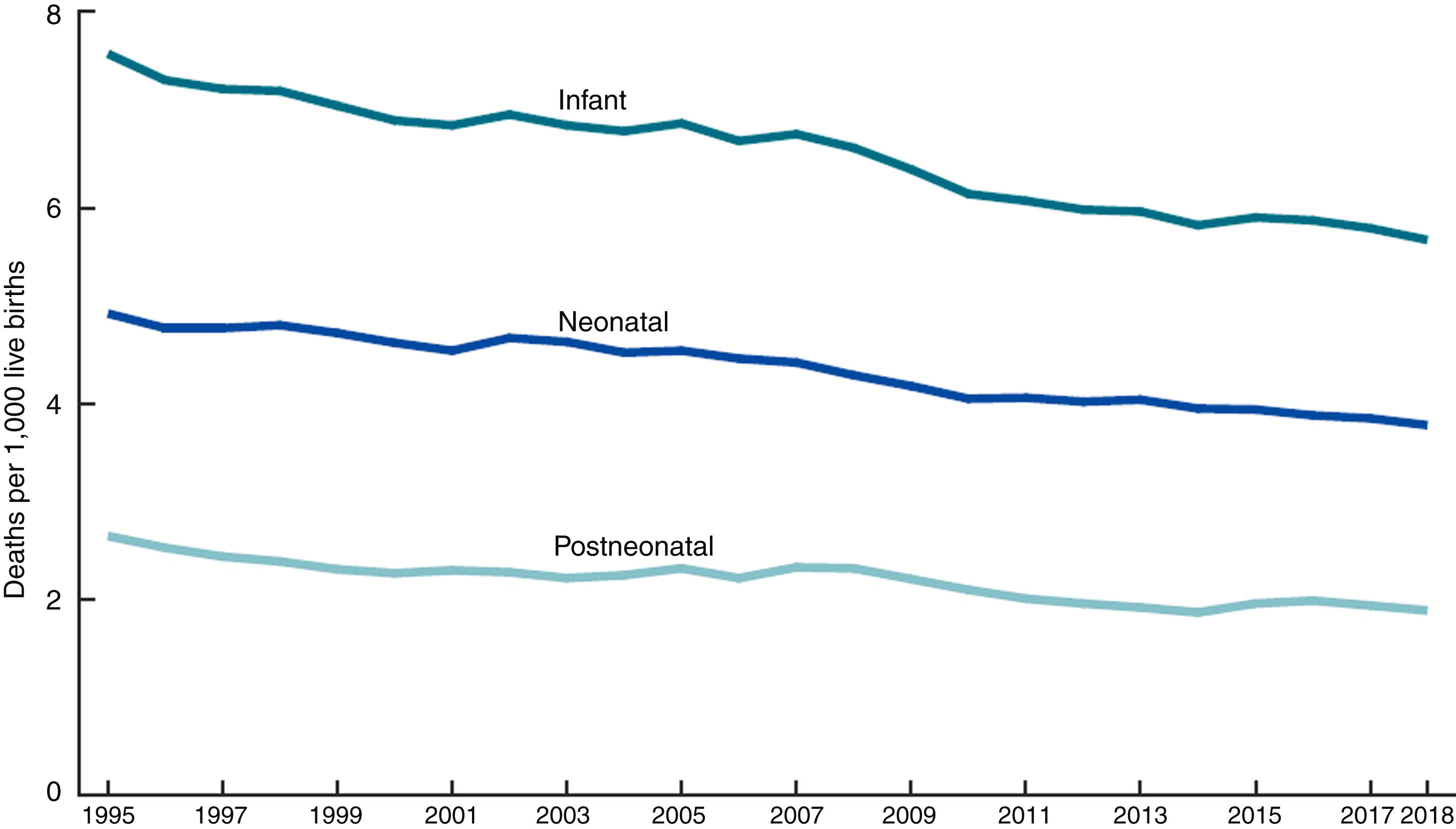
Fetal deaths account for more than half of perinatal deaths and are almost as frequent as infant deaths ( Fig. 38.6 ). In 2017, there were 13,443 fetal deaths and 14,329 neonatal deaths, with the large majority (80.8%) within seven days of birth. Despite the rising preterm birth rate, infant mortality has continued to trend down since 1995. This decline in perinatal mortality was related primarily to a decrease in fetal deaths after 28 weeks’ gestation, driven by a substantial decline in births and stillbirths after 40 weeks and because of an increase in indicated preterm births during this time. The infant mortality rates were 5.72 and 4.92 per 1000 live births for 2007 and 2013, respectively, with an absolute difference of −0.80 (14% decrease). Infant mortality rates declined by 11% for non-Hispanic Whites, by 19% for non-Hispanic Blacks, and by 14% for Hispanics during the period.
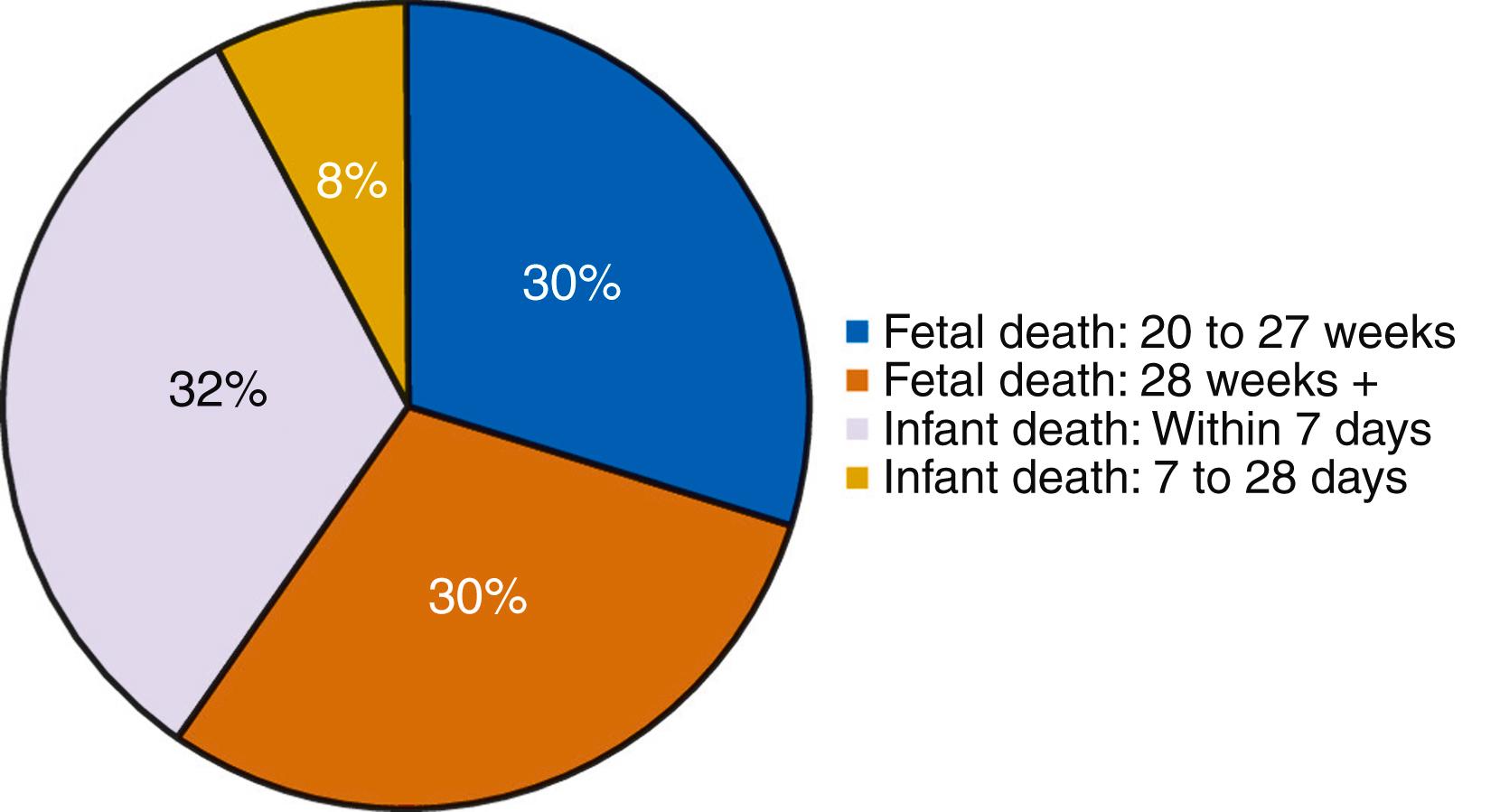
Gestational age–specific mortality decreased for each gestational age category between 2007 and 2013 except 33 weeks and greater than 42 weeks. About 31% of the decrease in the US infant mortality rate from 2007 through 2013 was due to changes in the gestational age distribution, and 69% was due to improvements in gestational age–specific survival. Improvements in the gestational age distribution from 2007 through 2013 benefited infants of non-Hispanic White women (48%) the most, followed by infants of non-Hispanic Black (31%) and Hispanic (14%) women.
Reports of survival and morbidity vary according to the denominator employed. Obstetric data sets include all living fetuses at entry to the obstetric suite, whereas neonatal data sets exclude intrapartum and delivery room deaths and thus report rates based on newborns admitted to the nursery. Rates of survival and morbidity at the same gestational age or birth weight are therefore somewhat higher in neonatal data sets and in data from tertiary care centers. A related phenomenon is the influence of inclusion or exclusion of pregnancy terminations. Terminations may occur without medical or obstetric indication, but they may also be performed for severe growth restriction, absence of amniotic fluid, pPROM, advanced cervical dilation, or a major anomaly detected at a previable gestational age above the lower threshold for defining preterm birth. Some of these fetuses either are liveborn or die before birth. From a pathophysiologic perspective, and in terms of the ultimate consequence of fetal/neonatal death, stillbirths before 24 weeks, spontaneous losses after 16 weeks, and terminations can have pathogenic features in common with other preterm births. Inclusion of stillbirths and pregnancy terminations will have a major influence on preterm birth frequency estimates and preterm birth–attributable mortality.
Gestational age is the strongest predelivery predictor of survival and morbidity for the infant. The perinatal mortality rate is strongly related to gestational age at birth, especially between 22 and 32 weeks ( Fig. 38.7 ). In 2018 infant mortality rate at <32 weeks was 185.79 per 1000 live births versus 21.95 at 32–33, 8.21 at 34–46, and 2.05 at 37–41 weeks. Although mortality declines sharply after 32 weeks, infants born between 32 and 37 weeks still have increased rates of adverse outcomes. A French study of outcomes at 5 years of age for infants born between 30 and 34 weeks found a progressive decline in rates of perinatal mortality and neonatal morbidity with advancing gestational age at birth. Rates of cerebral palsy and cognitive impairment at 5 years of age also declined with advancing gestational age at birth. ,
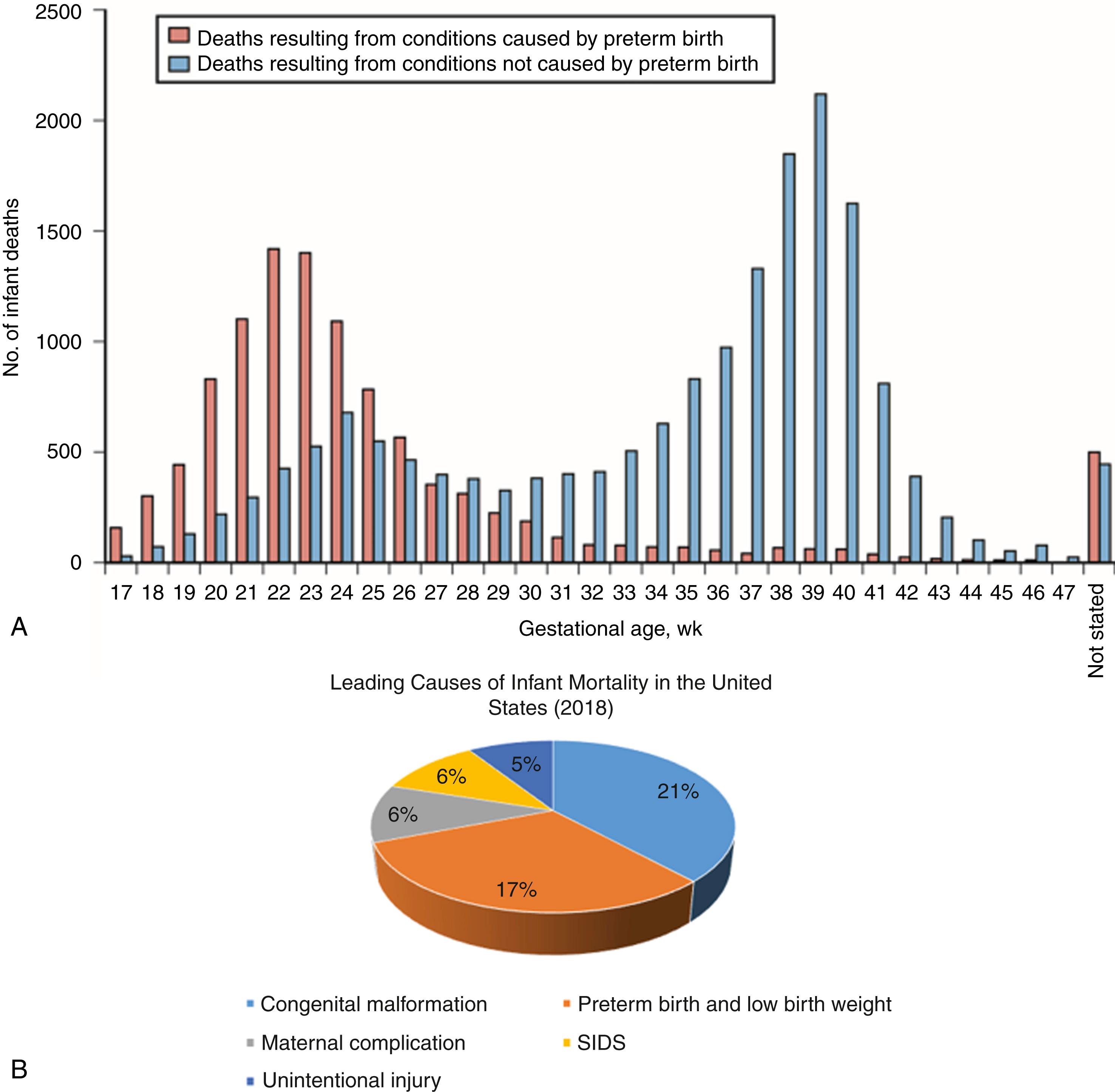
After delivery, birth weight and neonatal sex can be combined with gestational age to predict mortality. Estimates of neonatal outcomes for infants with birth weights of 400 to 1000 g that are based on gestational age, birth weight, sex, treatment with antenatal glucocorticoids, and multiple versus singleton gestation are available from the Eunice Kennedy Shriver National Institute of Child Health and Human Development (NICHD) website ( https://www1.nichd.nih.gov/epbo-calculator/Pages/ebpo_case.aspx ).
Regionalized care for high-risk mothers and infants, antenatal treatment with glucocorticoids, neonatal administration of exogenous pulmonary surfactant, and improved ventilator technology have produced survival rates that now exceed 90%, and survival without major morbidity in more than 80% of infants born at 28 weeks’ gestation or weighing 1000 g at birth.
Increasing attention has been paid to infants born at the periviable thresholds of age (22 to 25 weeks’ gestation) and weight (400 to 600 g). The NICHD Neonatal Research Network (NRN) reported a decrease in mortality over the past two decades, with the greatest gains in survival seen among infants born at 23 and 24 weeks of gestation after 2008. , A large cohort study sponsored by NICHD found that survival without neurodevelopment impairment among periviable infants improved between 2000 and 2011. In the period between 2008 and 2011, 20% of infants born at 22–24 weeks’ gestation survived without neurodevelopmental impairment. In 2017, the Society for Maternal-Fetal Medicine (SMFM) and the American College of Obstetricians and Gynecologists (ACOG) produced an obstetric care consensus statement on perinatal care at the limits of viability (see Chapter 73 ).
Perinatal deaths, just as preterm births, vary significantly by maternal race and ethnicity. In 2018, the infant mortality rate for non-Hispanic Blacks was highest among racial groups, and specifically more than double that for non-Hispanic Whites (10.75 versus 4.63 per 1000 live births). The relationship of maternal race to risk for neonatal mortality is complex. African-American infants have a greater overall perinatal mortality rate than do White or Hispanic infants. , This higher risk is related to an increased risk for stillbirth at all gestational ages, especially before 23 weeks’ gestation, and an increased risk for neonatal mortality for infants born at term and after term. However, neonatal mortality rates for Black preterm and LBW infants are lower than rates for other ethnic groups. ,
One important factor affecting mortality rates for preterm and very-low-birth-rate infants is use of antenatal glucocorticoids. In a cohort of 11,000 infants 22–28 weeks’ gestation, infants exposed to any antenatal glucocorticoid had a lower rate of death (2193/9670 [22.7%]) compared to infants without exposure (540/1302 [41.5%]) (adjusted relative risk, 0.71; 95% CI, 0.65–0.76; P < .0001). Infants exposed to a partial course of antenatal steroids also had a lower rate of death (654/2520 [26.0%]) compared to infants without exposure (540/1302 [41.5%]) (adjusted relative risk, 0.77; 95% CI, 0.70–0.85; P < .0001). Intrauterine infection adversely influences survival and morbidity. Mortality rates also vary among neonatal intensive care units, despite similar care practices and patient demographics. Therefore local statistics should be presented along with data from the NICHD website when counseling patients.
Preterm infants are at risk for specific diseases related to the immaturity of various organ systems and the cause and circumstances of preterm birth. Common complications in premature infants include respiratory distress syndrome (RDS), intraventricular hemorrhage (IVH), bronchopulmonary dysplasia, patent ductus arteriosus, necrotizing enterocolitis (NEC), sepsis, apnea, and retinopathy of prematurity. The frequency of major morbidity rises as gestational age decreases, especially before 32 weeks. There is wide geographic variation in the frequency of neonatal morbidities, especially for VLBW infants. Morbidity rates among survivors also vary according to the occurrence of adverse neonatal events (see also Chapter 73 ).
Major neonatal morbidities related to preterm birth that carry lifetime consequences include chronic lung disease, grades 3 and 4 IVH, NEC, and vision and hearing impairment. Increased rates of cerebral palsy, neurosensory impairment, reduced cognition and motor performance, academic difficulties, and attention deficit disorders are reported for preterm infants and rise in frequency as the gestational age at birth declines. , Approximately one-third of cases of cerebral palsy have been attributed to early preterm birth (<32 weeks’ gestation). Recent data support that the rate of survival without neurodevelopmental impairment increased between 2000 and 2011 in a large cohort of periviable infants. Health care workers regularly overestimate the likelihood and severity of neurologic morbidity in infants born before term. This is important, because these expectations may inappropriately influence parental care choices and subsequent neonatal outcomes.
Self-esteem among prematurely born infants followed to adolescence does not differ from that among persons born at term. Although 24% of 132 adolescents who weighed less than 1 kg at birth had significant sensory deficits, they did not differ from controls of normal birth weight in their self-perception of global self-worth, scholastic or job competence, or social acceptance.
Spontaneous preterm birth is like other multifactorial disorders, such as cancer or heart disease, wherein multiple endogenous and exogenous risk factors interact to cause disease. In the case of spontaneous preterm birth, such interaction generates the premature and often asynchronous initiation of one or more steps in parturition. As noted earlier, the clinical presentations of preterm labor, pPROM, and cervical insufficiency are indistinct and overlapping. Thus it is not surprising that the risk factors for preterm labor are similar to those for pPROM and cervical insufficiency.
While it would be expected that there would be intense evolutionary pressure against a genetic predisposition to preterm birth, studies showing familial risk patterns suggest that there may be heritable tendencies. Two large population-based cohort studies identified that a pregnant woman was at increased risk of preterm birth if her mother had ever had a preterm delivery. , Studies to date have employed both candidate gene and whole genome approaches to study DNA variants of biologically suspected genes, with limited insight into prematurity causation. , Genetic association studies have identified polymorphisms in several genes in the mother and fetus associated with spontaneous preterm birth. One of the largest genome-wide associations to date included over 40,000 women of European ancestry. They identified variants in the EBF1, EEFSEC, and AGTR2 loci associated with preterm birth. Genes at these loci have been implicated in uterine development, maternal nutrition, and vascular control, supporting a pathophysiological basis for their influence on preterm birth. Gene-environment interactions are more difficult to validate. Most recently, Hong and colleagues examined a cohort of 1733 Black women and identified that maternal COL24A1 variants had a significant interaction with maternal obesity and risk of preterm birth.
Alterations in the regulation of type I collagen expression and genetic disorders affecting collagen (e.g., Ehlers-Danlos syndrome) have been associated with increased risk for preterm birth. Familial collagen disorders may explain familial aggregation of cervical insufficiency. As an example, a study of women with and without cervical insufficiency observed that 27% of those with cervical insufficiency had a first-degree relative with the same diagnosis and had polymorphisms in the collagen type I α1 and transforming growth factor-β genes, which appear to be associated with this condition.
In addition to evolutionary pressure against mutations promoting preterm birth, another major limitation in the quest to identify gene sequence variants that increase risk for preterm birth is the aforementioned phenotypic heterogeneity of preterm births. The more pathophysiologically and epidemiologically varied the phenotype, the more difficulty there is in identifying a meaningful, parsimonious underlying genetic risk model. The multifactorial nature of preterm birth and the contribution of local (vaginal/uterine) and external environmental factors make identification of single genetic causes unlikely; continued study with techniques such as whole exome sequencing that continue to identify candidate genetic loci and pathways, including immune and inflammatory systems, may shed further light on familial trends.
There are multiple socioeconomic contributors to preterm birth risk. A 2016 cross-sectional study of US birth certificates found that in addition to maternal education, marital status and insurance status were significant contributors to preterm birth risk and to the disparity in preterm birth risk between Black and White non-Hispanic populations ( Fig. 38.8 ).
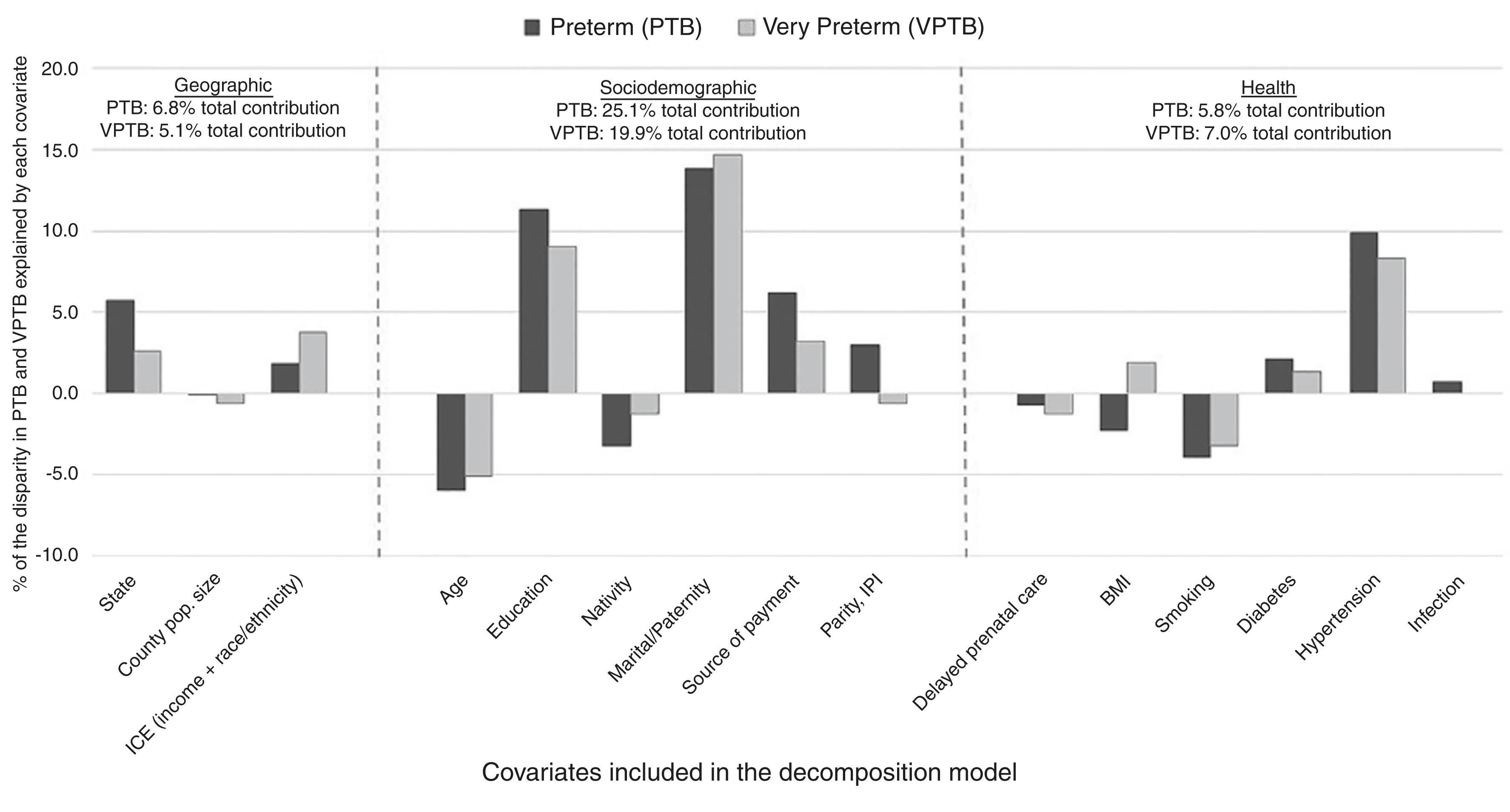
Rates of preterm birth are almost twofold higher among African-American and Afro-Caribbean women (16% to 18%) than among Asian, Hispanic, and White women in the United States and the United Kingdom (UK). Preterm births before 34 weeks are also increased in Black women compared with women from other racial or ethnic groups ( Fig. 38.9 ). Rates of preterm and LBW infants remain higher for Black women than for White, Asian, or Hispanic women, after controlling for social disadvantage and education.
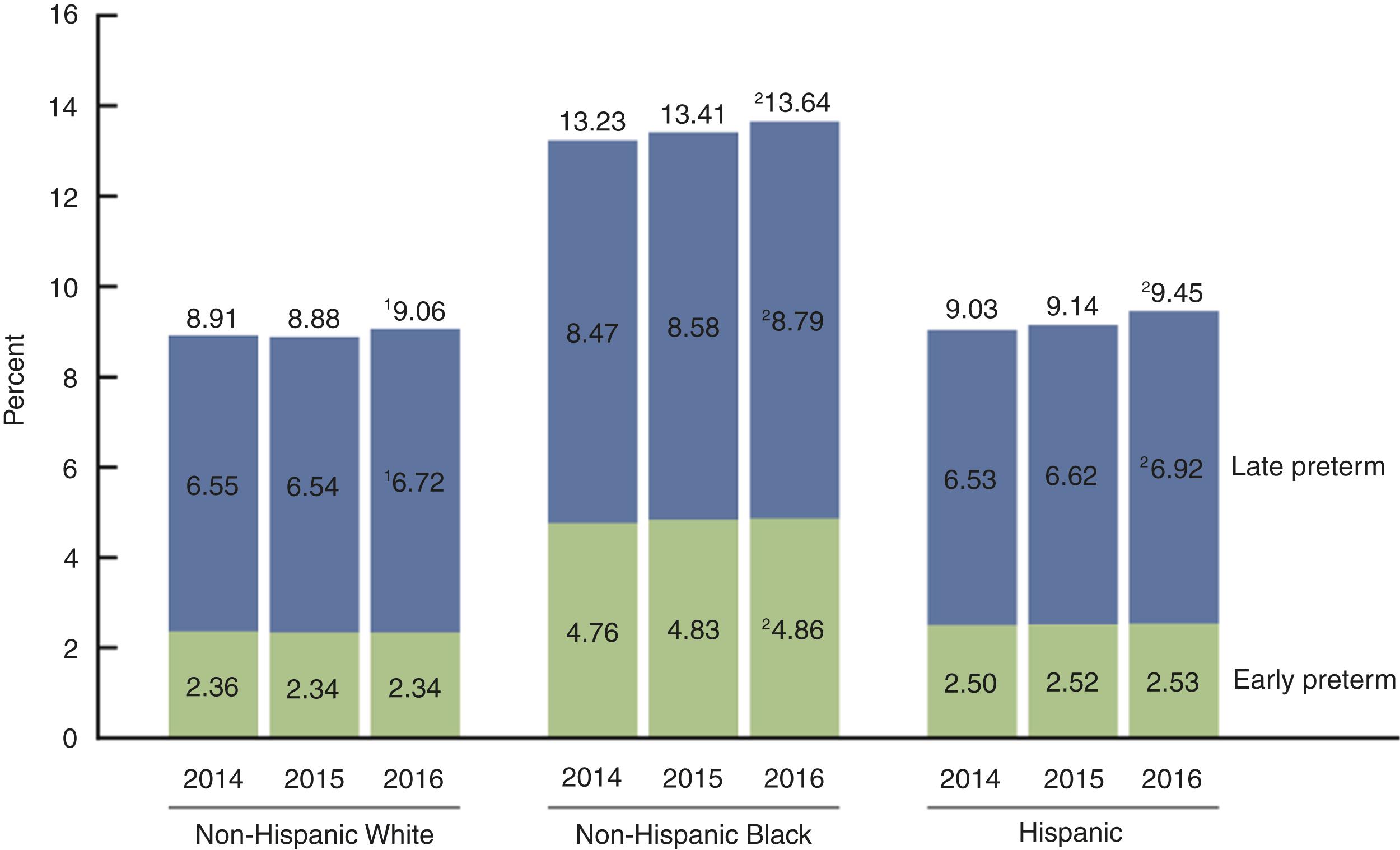
Rates of preterm birth among Arab-American women are the same as or lower than those among non-Hispanic White women, despite increased socioeconomic risk. Rates of preterm delivery among Black women born outside the United States are generally lower than among African-American women or among Afro-Caribbean women living in the UK, highlighting the impact structural racism has on preterm birth risk.
Maternal tobacco use is related to poor pregnancy outcomes such as fetal growth restriction, placental abruption, infant mortality, and preterm birth. The prevalence of smoking in pregnancy was 6.0% in 2019, a decline from 2018. Nonetheless, because of its association with preterm birth, and the potential for successful intervention, even during pregnancy, smoking cessation efforts are an important part of prenatal care. , The mechanisms by which smoking is related to preterm birth are unclear, but nicotine and carbon monoxide are vasoconstrictors that decrease uteroplacental blood flow. Smoking also affects the immune system. Neutrophil degranulation and superoxide production are increased in smokers. Cytokine production after in vivo or in vitro stimulation is greater in smokers than in nonsmokers. Cigarette smoking in pregnancy is associated with an increase of cervical antiinflammatory cytokines without a commensurate increase of proinflammatory cytokines. This may have adverse effects on the host response to infection. The biologic effects of smoking may differ by race; for example it has been shown that Blacks manifest a higher nicotine intake per cigarette and slower clearance of cotinine (the major nicotine metabolite) in response to cigarette smoking.
Substance use/abuse may be linked to preterm birth risk directly, as well as through concurrent exposure to lifestyle-related risk factors such as limited prenatal care, nutritional deficiencies, genital tract infections, and cigarette smoking. Opiate use disorder has consistently been associated with increased rates of preterm birth, even with medication-assisted treatment. Marijuana use has not been independently related to preterm birth. Initial reports associating cocaine with preterm birth resulting from abruption may have been influenced by ascertainment bias; the magnitude of the risk for preterm birth among cocaine users is now considered uncertain (see Chapter 68 ). Maternal alcohol consumption has a complex association with preterm birth, with some studies showing no relationship or even a modest reduction in the rate of preterm birth among light drinkers, , and others confirming an increased risk related to regular and heavy alcohol intake. , Due to concurrent risk factors including polysubstance use, tobacco use, and socioeconomic factors, it can be difficult to isolate the individual impact of any one substance, although this has been studied as well.
Environmental exposures may also predispose to preterm birth. For example, in a geospatial population-based cohort study using live birth records from Ohio (2007–10) linked to average daily measures of fine (upper limit of 2.5 μm) particulate matter (PM 2.5 ) air pollution, recorded by 57 Environmental Protection Agency network monitoring stations across the state, exposure to high levels of PM 2.5 air pollution during pregnancy is associated with a 19% increased risk of preterm birth, with the greatest risk with high third-trimester exposure. Although the risk increase associated with high PM 2.5 levels is modest, the potential impact on overall preterm birth rates is robust because all pregnant women are potentially at risk.
Studies relating preterm birth risk to stress during pregnancy generally report a modest relationship, with relative risks (RRs) of 1.3 to 1.4 for stressful life events such as death of a family member, loss of employment, or divorce. Stress is often accompanied by other known risk factors, such as socioeconomic disadvantage, smoking, or Black race. Lu and Chen found that adding stress to a statistical model of risk factors for preterm birth in 33,542 women had little effect on the observed relationship between race and preterm birth; they concluded that stressful life events, even events immediately preceding or during pregnancy, do not significantly contribute to racial and ethnic disparities in preterm birth. Chronic stress may influence preterm birth risk by altering immunologic function. , Chronic stress related to long-term exposure to cultural prejudices and racism is a potential explanation for the disparity in preterm birth rates between African-American or Afro-Caribbean women and women of other ethnic backgrounds. One study in a majority Black cohort found that high maternal stress and low cervicovaginal beta defensin-2 were associated with an increased risk of spontaneous preterm birth. In contrast, a large prospective cohort study (nuMoM2b) found increased rates of preterm birth in non-Hispanic Black women, not explained by self-reported psychosocial factors.
Depression before and during pregnancy is a risk factor for adverse pregnancy outcomes, including preterm birth. Clinical depression occurs in as many as 15% to 35% of women. The reported relationship between depression and risk for preterm birth is modest (less than twofold). , Risk factors for depression are similar to those related to preterm birth and include non-Hispanic Black race, young age, limited education, and exposure to stressful life events (see also Chapter 67 ).
Work and physical activity have been studied in relationship to risk for preterm birth, with conflicting results. Although rates of preterm birth are lower in women who are employed than in those who are unemployed, the risk among employed women may be increased by work that is physically demanding or stressful. A 2019 meta-analysis found that working night shift was associated with an increased risk of preterm birth (OR = 1.21; 95% CI, 1.03–1.42) and miscarriage (OR = 1.23; 95% CI, 1.03–1.47). Working longer hours was associated with an increased risk of preterm birth, low-birth-weight infant, and small-for-gestational-age infant in a dose-dependent manner. Finally, working rotating shifts was also associated with increased odds of preterm birth (OR = 1.13; 95% CI, 1.00–1.28), small-for-gestational-age infants (OR = 1.18; 95% CI, 1.01–1.38), and preeclampsia (OR = 1.75; 95% CI, 1.01–3.01).
In contrast, a 2017 meta-analysis found that maternal exercise was associated with a reduced risk of hypertensive disorders of pregnancy (RR = 0.70; 95% CI, 0.53–0.83). Another meta-analysis of randomized controlled trials found that aerobic exercise in pregnancy was not associated with an increased risk of preterm birth but was associated with a reduced risk of gestational diabetes, hypertensive disorders of pregnancy, and cesarean delivery.
Coitus during pregnancy commonly leads to a transient increase in uterine activity and is an opportunity to acquire genital tract infections, but self-reported sexual activity was not related to the risk for preterm birth in a study of women with a prior preterm birth, nor was it associated with adverse perinatal outcomes. The practice of douching before or during pregnancy has been suggested to increase the risk for preterm birth, but the association is confounded by the higher prevalence of bacterial vaginosis (BV) in Black women, who are more likely to practice douching. ,
The risk for preterm birth has been related to maternal nutritional status during pregnancy, as measured by BMI, nutritional intake, and serum markers of nutritional status. Low maternal prepregnancy weight and BMI have consistently been associated with spontaneous preterm birth. After adjusting for confounders, Moutquin noted that women with a BMI of less than 20 were nearly four times as likely as heavier women to have a spontaneous preterm birth. Indeed, the relationship between low prepregnancy BMI and spontaneous preterm birth is consistent (OR = 1.7 to 3.9) among North American Whites, African Americans, and urban Latinas. , Low BMI also modifies the contribution of low pregnancy weight gain to the risk for preterm birth. Compared with normal-weight women with adequate weight gain, the risk for spontaneous preterm birth at less than 37 weeks’ gestation is sixfold greater for underweight women with poor gain and threefold greater for normal-weight women with poor gain.
Micronutrients have been studied in preterm birth prevention as well. Women with low serum iron, folate, or zinc levels have more preterm births than those with measurements in the normal range. A 2019 Cochrane review concluded that multiple micronutrient supplementation likely led to a reduction in very preterm births (RR = 0.81; 95% CI, 0.71–0.93), which was even more marked among those who were low BMI. The review found that multiple micronutrients with iron and folic acid versus iron with or without folic acid may also reduce rate of preterm birth, although the effect size is limited (RR = 0.95; 95% CI, 0.90–1.01). The benefits were greater for those with low BMI, and most studies were from low/middle income countries. Thus micronutrient supplementation is likely beneficial in low/middle income countries or in undernourished patient populations, and there is no evidence to support universal use of micronutrients for primary prevention of preterm birth in the United States.
There are contradictory studies on the association between vitamin D deficiency and preterm birth. Most recently, a Cochrane review in 2019 including 22 trials and 3725 participants found that vitamin D likely reduced risk of preeclampsia (RR = 0.48, 0.30–0.79) and low birth weight <2500g (RR = 0.55, 0.35–0.87) but not preterm birth <37 weeks (RR = 0.66, 0.34–1.30).
(See also Chapter 48, Chapter 49, Chapter 50, Chapter 51 .)
The risk for preterm birth related to infection is sometimes considered to be a risk that is acquired during pregnancy—an accurate concept for extragenital infections such as pyelonephritis or pneumonia, but one that does not fully apply to genital tract colonization and infection. Prepregnancy colonization of the upper and lower genital tract and the maternal immune response to that colonization are increasingly recognized as important aspects of infection-related risk for preterm birth. The correlation between genital tract infection and preterm birth has long been recognized, but the pathways by which infection leads to preterm birth have not, until recently, been understood to involve activation of the innate immune system. Microorganisms are recognized by pattern recognition receptors such as Toll-like receptors, which, in turn, elicit the release of inflammatory chemokines and cytokines such as IL-8, IL-1β, and TNF-α. During intrauterine infection, microbial products and proinflammatory cytokines stimulate the production of prostaglandins and other inflammatory mediators as well as matrix-degrading enzymes. Prostaglandins stimulate uterine contractility, and degradation of extracellular matrix in the fetal membranes leads to pPROM. The contribution of infection to preterm birth has been estimated to be 25% to 40% based on microbiologic studies, but this may be an underestimate, because intrauterine infection is difficult to detect with conventional culture techniques. For example, molecular microbiological studies based on the polymerase chain reaction (PCR) demonstrate Ureaplasma urealyticum in amniotic fluid samples with negative cultures. , More recently, the vaginal microbiome has been studied for its relationship to preterm birth risk. One case-control study found specific bacterial taxa to be significantly associated with preterm birth and with short cervix, a precursor to preterm birth. ,
Intrauterine colonization and infection can occur in the decidua, the choriodecidual and chorioamniotic space, or the amniotic cavity. Because microbial colonization is more common in the chorioamnion than in the amniotic cavity, amniotic fluid cultures underestimate the contribution of infection to preterm birth. However, bacteria are known to be present in the chorioamnion in women who deliver healthy infants at term, indicating that bacteria in the chorioamnion do not always generate an inflammatory response that leads to preterm labor and birth. The most common pathway by which microorganisms gain access to the choriodecidua and amniotic cavity is probably ascent from the vagina and the cervix, but the timing of this spread is uncertain. It may occur before or during pregnancy. Regardless of when colonization occurs, intrauterine inflammation is postulated to cause clinical symptoms, such as vaginal discharge, cervical effacement, ruptured membranes, or labor, only when microbial counts increase as the membranes try to adhere to the decidua in the second trimester. This phenomenon is consistent with the strong association between increased concentrations of fetal fibronectin, the choriodecidual “glue,” in vaginal fluid between 13 and 22 weeks’ gestation, with spontaneous preterm birth in the second trimester. , The microorganisms most commonly recovered from the amniotic cavity and chorioamnion are genital mycoplasma species, especially U. urealyticum, and other organisms of low virulence, consistent with the chronicity of intrauterine infections and the frequent lack of overt clinical signs of infection.
Bacterial vaginosis (BV), an alteration in the microbial ecosystem of the vagina, is a clinical correlate of lower and upper genital tract infection. It is diagnosed clinically by the presence of clue cells, a vaginal pH greater than 4.5, a profuse white discharge, and a fishy odor when the vaginal discharge is exposed to potassium hydroxide. Bacterial vaginosis in pregnancy has been consistently associated with an increased risk for preterm birth, but apparently only as a marker, because eradication of BV from the genital tract of pregnant women does not consistently reduce the likelihood of preterm birth. , BV is more commonly detected in Black women where it is also more strongly related to preterm birth. This association is unrelated to differences in sexual behaviors. Moreover, as noted, eradication of BV does not reduce the risk for preterm birth in either Black or White women. , ,
Trichomonas vaginalis is present in 3.1% of women of reproductive age, and it is also more common among Black women (13%) than in other groups. It has been associated with a modest increase in the risk for preterm birth (RR = 1.3) in some but not all studies.
Sexually transmitted infections, including Chlamydia trachomatis, syphilis, and gonorrhea, confer an increased risk for preterm birth approaching twofold, but eradication of these organisms does not reduce that risk, suggesting involvement of host factors.
Extragenital infections, including pyelonephritis, asymptomatic bacteriuria, pneumonia, and appendicitis, are also associated with preterm birth through mechanisms that are not well understood. ,
Maternal periodontal disease has been linked to an increased risk for preterm birth, but the pathogenic basis for the association is uncertain. It most likely results from shared variations in microbial states and associated inflammatory responses in the oral and genital tracts. Goepfert and colleagues demonstrated that, after adjusting for other factors, periodontal disease was not related to increased intrauterine bacterial colonization, histologic chorioamnionitis, or cord blood cytokine levels. Variations in host response to microbial colonization related to genetic polymorphisms or concurrent environmental exposures, or both, have been proposed as contributors to the disparate rates of preterm birth among ethnic groups, particularly in relationship to infection-driven preterm birth, and this may apply to other inflammation at extragenital sites, such as periodontal inflammation. A recent meta-analysis of 11 randomized trials with a total of 5671 participants showed no clear difference in preterm birth less than 37 weeks’ gestation (RR = 0.87; 95% CI, 0.70–1.10; low-quality evidence) between periodontal treatment and no treatment.
Women with müllerian duct fusion anomalies have an increased risk for pregnancy loss, with clinical presentations that vary according to uterine anatomy, cervical involvement, and placental implantation site. , Preterm births are reported in 25% to 50% of pregnancies among women with uterine malformations. , Among 246 pregnancies in 130 women with uterine anomalies, 20.3% were delivered preterm, 8.5% delivered in the second trimester, and 25% were first-trimester losses. The preterm birth rate was particularly increased (approximately 35%) in women with bicornuate, didelphys, or arcuate uteri, compared with those who had septate or subseptate uteri (approximately 15%) in this report. Müllerian fusion anomalies may involve the cervix as well as the uterine cavity, so the clinical presentation may include cervical insufficiency, bleeding related to abnormal placental implantation, and preterm labor. Clinical presentations leading to preterm birth in a study of 61 women with uterine anomalies included preterm labor in 39%, pPROM in 13.7%, and abruption in 5.9%. Prenatal exposure to diethylstilbestrol is associated with an increased risk for preterm labor and birth related to the typical T-shaped uterine anomaly. However, these studies should be interpreted with caution due to selection bias since uterine abnormalities are usually only ascertained in women with obstetric complications. Most women with uterine anomalies have normal pregnancies.
Women treated for cervical dysplasia with a loop electrosurgical excision procedure (LEEP), or with cervical conization using either laser or cold knife, have an increased risk for later preterm birth, but the basis of the association is uncertain. The largest studies of this relationship have come from Scandinavian registries in which long-term follow-up is possible. Among 8210 women treated surgically for dysplasia between 1986 and 2003, the risk for preterm birth before 37 weeks’ gestation was increased after cervical conization (RR = 1.99; 95% CI, 1.81–2.20), as were the risks for birth between 28 and 31 weeks (RR = 2.86; 95% CI, 2.22–3.70) and before 28 weeks (RR = 2.10; 95% CI, 1.47–2.99). Risks of LBW and perinatal death were also increased after conization (RR = 2.06; 95% CI, 1.83–2.31; and RR = 1.74; 95% CI, 1.30–2.32, respectively). A Danish cohort of 11,088 women was monitored from 1991 through 2004; of 14,982 deliveries in the cohort, 542 occurred between 21 and 37 weeks. The rate of preterm birth was 3.5% in women with no previous LEEP and 6.6% in women previously treated with LEEP (OR = 1.8; 95% CI, 1.1–2.9). A meta-analysis suggested that women with a history of LEEP have a similar risk of preterm birth when compared to women with prior dysplasia but no cervical excision. Common risk factors for both preterm birth and dysplasia likely explain findings of association between LEEP and preterm birth, but LEEP itself may not be an independent risk factor for preterm birth. This suggests that host factors may be more important than treatment in explaining the associations observed by others.
Although most women who experience a preterm birth will deliver at term in subsequent pregnancies, the recurrence risk for spontaneous preterm birth is twofold or higher. This yields an actual risk that ranges from 15% to 20% to more than 50% to 60% when maternal race, ethnicity, and the number and gestational age of prior preterm deliveries are considered. The recurrence risk rises in women of all races as the number of prior preterm births increases, with a nearly twofold rise for each prior preterm birth. The most recent birth is the most predictive ( Fig. 38.10 ).
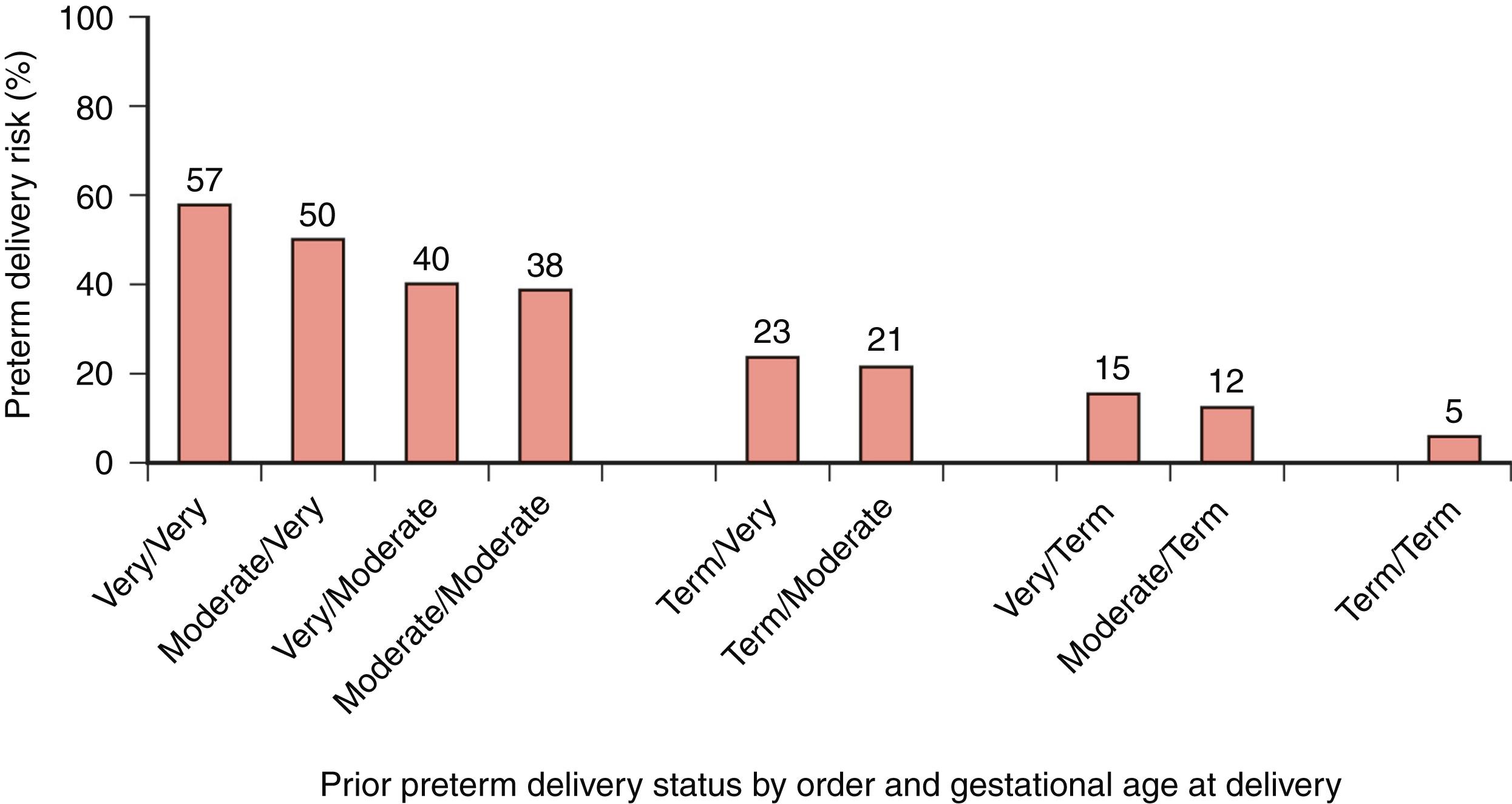
The risk increases further as the gestational age of the index preterm birth declines, especially with gestational age before 32 weeks. A prior preterm birth as early as 16 to 18 weeks has been found to confer an increased risk in subsequent pregnancies. ,
The risk for recurrence is almost twofold higher for non-Hispanic Black women than for any other group. Adams and colleagues related maternal race and gestational age of the initial preterm birth to recurrence risk. If the first preterm birth occurred before 32 weeks, the risk for recurrent preterm birth was 28% for White women and 36% for Black women. When multiple risk factors occur in Black women, recurrence rates exceeding 50% have been reported. , In a placebo-controlled trial of 17-hydroxyprogesterone caproate to reduce the risk for recurrent preterm birth, 54% of women in the placebo arm delivered before 37 weeks’ gestation, and 30.7% delivered before 35 weeks. The mean gestational age at delivery in the qualifying pregnancy was 31.3 ± 4.2 weeks; 46% of subjects had more than one prior preterm birth, and 59% were Black. In another study of 611 women with one (75%) or more (25%) prior preterm births, 40% delivered before 37 weeks, and 25% delivered before 35 weeks’ gestation. One-quarter of the subjects in this trial were Black. These rates are consistent with prior studies showing a 1.5-fold to twofold increased risk for each risk factor (Black race, more than one prior preterm birth, and gestational age <32 weeks) , , , and with prior observational studies.
The mechanisms of recurrence are not clear but have been related to short cervix, infection, and short interpregnancy interval. After adjusting for confounding variables, a short interval between pregnancies is associated with a twofold increased risk for preterm birth. A short interpregnancy interval is more common among women whose first birth was a preterm birth.
Prior preterm birth of twins confers an increased risk for preterm birth in a subsequent singleton pregnancy that is related to the gestational age at delivery of the index twin pregnancy. A 2020 meta-analysis found for a singleton pregnancy following a twin preterm birth, the risk of subsequent preterm birth increased with decreased gestational age of prior twin pregnancy, with an OR of 9.78 (95% CI, 4.99–18.98) with a prior twin delivery <30 weeks to an OR of 2.13 (95% CI, 1.21–3.74) with a prior twin delivery 34–36 weeks.
Women with indicated preterm births also have an increased risk for another indicated preterm birth, because the underlying condition (e.g., maternal diabetes, hypertension) often persists. , Unexplained fetal growth restriction can also be recurrent. , In a recent large cohort study, there were 3836 women who delivered preterm in the first observed pregnancy (7.6%), of whom 1160 repeated in the second (30.7%). The rate of recurrent preterm delivery was 31.6% for prior spontaneous, 23.0% for prior indicated, and 27.4% for prior elective preterm delivery. Prior spontaneous preterm delivery was associated with an RR of 5.64 (95% CI, 5.27–6.05) of subsequent spontaneous preterm delivery and an RR of 1.61 (95% CI, 0.98–2.67) of subsequent indicated preterm delivery. Prior indicated preterm delivery was associated with an RR of 9.10 (95% CI, 4.68–17.71) of subsequent indicated preterm delivery and an RR of 2.70 (95% CI, 2.00–3.65) of subsequent spontaneous preterm delivery. Thus prior indicated preterm delivery was strongly associated with subsequent indicated preterm delivery and with increased risk for subsequent spontaneous preterm delivery.
As noted above, the risk for preterm birth is increased as the gestational age at birth of a prior preterm pregnancy falls. Data from the Stillbirth Collaborative Research Network demonstrated that this observation extends to include spontaneous births that occur before the threshold of viability, so that a history of stillbirth before 24 weeks’ gestation or “late miscarriage” between 16 and 20 weeks also confers an increased risk for spontaneous preterm birth after 20 weeks in future pregnancies. This observation is important because these women may be candidates for progesterone prophylaxis, or at least for transvaginal screening of cervical length.
Some studies suggest that history of induced abortion is related to an increased risk for preterm birth in subsequent pregnancies. Women with more than one induced abortion have been found in several studies to have a higher risk for subsequent preterm birth, especially for births before 28 to 32 weeks’ gestation. A case-control survey of 2938 preterm and 4781 term births in 10 countries reported that women with a history of induced abortions were significantly more likely to have a subsequent spontaneous preterm delivery. A prior induced abortion did not affect the risk for subsequent indicated preterm birth. The risk for preterm birth increased with the number of abortions, and the strength of the association increased with decreasing gestational age at birth. In another study of 12,432 women, rates of preterm delivery were compared according to the occurrence and number of previous induced abortions; other risk factors were controlled for. Previous induced abortion was associated with an increased risk for preterm birth (OR = 1.4; 95% CI, 1.1–1.8), and the risk for preterm birth increased with the number of previous induced abortions (OR = 1.3; 95% CI, 1.0–1.7 for one previous abortion; and OR = 1.9; 95% CI, 1.2–2.8 for two or more). Saccone and associates conducted a meta-analysis of 36 studies including 1,047,683 women. Thirty-one studies reported data about prior uterine evacuation for termination, whereas five studies reported data for spontaneous abortions. In the overall population, women with a history of uterine evacuation for either elective termination or spontaneous abortion had a significantly higher risk of preterm birth (5.7% versus 5.0%; OR = 1.44; 95% CI, 1.09–1.90), an LBW infant (7.3% versus 5.9%; OR = 1.41; 95% CI, 1.22–1.62), and a small-for-gestational-age infant (10.2% versus 9.0%; OR = 1.19; 95% CI, 1.01–1.42) compared with controls. Of the 31 studies on termination, 28 included 913,297 women with a history of surgical termination, whereas 3 included 10,253 women with a prior medical termination. Women with a prior surgical termination had a significantly higher risk of preterm birth (5.4% versus 4.4%; OR = 1.52; 95% CI, 1.08–2.16), an LBW infant (7.3% versus 5.9%; OR = 1.41; 95% CI, 1.22–1.62), and an SGA infant (10.2% versus 9.0%; OR = 1.19; 95% CI, 1.01–1.42) compared with controls. Women with a prior medical termination had a similar risk of preterm birth compared with those who did not have a history of induced termination of pregnancy (28.2% versus 29.5%; OR = 1.50; 95% CI, 1.00–2.25). Five studies, including 124,133 women, reported data on subsequent pregnancy in women with a prior spontaneous abortion. In all included studies, the spontaneous abortion was surgically managed. Women with a prior surgical procedure for a spontaneous abortion had a higher risk of preterm birth compared with those who did not have a history of spontaneous abortions (9.4% versus 8.6%; OR = 1.19; 95% CI, 1.03–1.37). One study found that prior uterine evacuation procedure (for spontaneous or elective abortion) was associated with an increased incidence of short cervix, which may provide a causative pathway for the association with preterm birth.
However, a very large, population-based registry study from Scotland noted a change in this association over time. Overall, previous abortion was associated with an increased risk of preterm birth (OR = 1.12; 95% CI, 1.09–1.16), but when analyzed by year of delivery, the association was strongest in 1980–83 (OR = 1.32; 95% CI, 1.21–1.43), progressively declined between 1984 and 1999, and was no longer apparent in 2000–03 (OR = 0.98; 95% CI, 0.91–1.05) or 2004–08 (OR = 1.02; 95% CI, 0.95–1.09). Thus it is possible that more modern approaches to abortion, such as medical abortion or newer surgical approaches, attenuate the positive relation seen in earlier time epochs.
Vaginal bleeding related to placental abruption or placenta previa is a recognized cause of preterm delivery, but bleeding of uncertain origin has also been associated with spontaneous preterm birth, especially if the bleeding is recurrent or persistent. , The mechanism by which bleeding is associated with preterm birth occurring weeks later is uncertain. The observation of an increased risk for preterm birth in pregnancies complicated by an elevated maternal serum alpha-fetoprotein not explained by structural fetal anomalies may be related. First-trimester bleeding in singleton pregnancies after assisted reproductive technology (ART) has been associated with an increased risk for preterm birth. In a review of 1432 singleton pregnancies conceived after ART, women with first-trimester bleeding had increased rates of pPROM (OR = 2.44; 95% CI, 1.38–4.31), birth before 37 weeks’ gestation (OR = 1.64; 95% CI, 1.05–2.55), and birth before 32 weeks’ gestation (OR = 3.05; 95% CI, 1.12–8.31). The rate of preterm birth also increases when one fetus in a multifetal gestation is lost, a finding noted among surviving singletons in multifetal gestation conceived by in vitro fertilization (IVF) but not in spontaneously conceived pregnancies. The risk for preterm birth is increased further in higher order multiple gestations intentionally reduced to twins than in gestations of spontaneous twins. These reports suggest that disturbance of the maternal-fetal interface in early pregnancy may be associated with risk for preterm parturition.
Preterm birth is more common in pregnancies conceived after ovulation induction and ART, including IVF and gamete and zygote intrafallopian transfer, frozen embryo transfer, and donor embryo transfer. In the United States in 2014, ART-conceived infants contributed to 4.7% of all preterm (<37 weeks’ gestation) infants (range: 1.2% in Puerto Rico to 13.4% in Massachusetts). Percentages of preterm births were higher among infants conceived with ART (33.2%; range: 18.9% in the District of Columbia to 45.9% in Puerto Rico) than among all infants born in the total birth population (11.3%; range: 8.5% in California to 16.0% in Mississippi).
The increased rate of preterm birth after ART is observed in singleton as well as multifetal pregnancies. A 2018 meta-analysis of cohort studies found an increased risk of spontaneous preterm birth <37 weeks (OR = 1.75; 95% CI, 1.50–2.03) and <34 weeks (OR = 1.78; 95% CI, 1.03–3.08), but no difference in neurodevelopmental, gastrointestinal, infectious, or respiratory morbidity in singletons conceived by IVF/ICSI compared to spontaneously conceived singletons. A 2016 meta-analysis found that pregnancies conceived by any type of ART were at increased risk of preterm birth (RR = 1.71; 95% CI, 1.59–1.83), very preterm birth (RR = 2.12; 95% CI, 1.73–2.59), low birth weight (RR = 1.61; 95% CI, 1.9–1.75), very low birth weight (RR = 2.12; 95% CI, 1.84–2.43), and perinatal mortality (RR = 1.64: 95% CI, 1.41–1.90).
Potential mechanisms for these associations have been explored in studies from large, prospectively collected data sets such as the Society for Assisted Reproductive Technologies (SART) database , and the First- and Second-Trimester Evaluation of Risk (FaSTER) study, and elsewhere. A secondary analysis of FaSTER data found significant associations between ovulation induction and placental abruption, fetal loss after 24 weeks, and gestational diabetes, and between IVF and preeclampsia, gestational hypertension, and placental abruption. LBW, but not preterm birth, occurred more commonly among infants born after fresh, compared with frozen and thawed, embryo transfer. Others have reported a threefold increase in preterm and LBW infants in singletons conceived after controlled stimulation of ovulation (e.g., with clomiphene as well as gonadotropins). Notably, a SART study found that extended culture of embryos from cleavage stage to blastocyst stage was associated with an increased risk for preterm birth. Singleton IVF births conceived after blastocyst transfer were at an increased risk for preterm delivery when compared with births after cleavage-stage transfer (18.6% versus 14.4%, respectively; adjusted OR = 1.39; P < .001) and very preterm delivery (2.8% versus 2.2%, respectively; adjusted OR = 1.35; P < .001). Host factors linked to both subfertility and preterm birth, and medication effects, are other possible explanations for these associations.
(See also Chapter 37 .)
Multifetal gestations have a sixfold increased risk for preterm birth compared with singleton pregnancies. The risk increases with fetal number. In the United States, about 20% of all preterm infants are the product of the ∼3% of pregnancies that are multifetal. More than 50% of twins are born preterm, most often after spontaneous labor or pPROM before 37 weeks’ gestation. The remainder deliver preterm because of maternal or fetal conditions such as preeclampsia or growth restriction. Almost all higher order multiple gestations deliver before term. The risk for early birth rises with the number of fetuses, suggesting uterine overdistention and fetal signaling as potential pathways to early initiation of labor ( Table 38.2 ). Nevertheless, nearly half of women with twins deliver after 37 weeks’ gestation, suggesting that uterine stretch or distention is variably accommodated according to maternal characteristics, including cervical length, physical activity, uterine tone, and other risk factors.
| Births | |||||
|---|---|---|---|---|---|
| Single | Twin | Triplet | Quad | Quint and higher order | |
| Gestational Age | |||||
| <34 wk | 2.14 | 19.96 | 62.90 | 85.09 | 100 |
| <37 wk | 8.47 | 60.87 | 98.50 | 95.61 | 100 |
| Birth Weight | |||||
| <1.5 kg | 1.09 | 9.40 | 34.10 | 61.40 | 100 |
| <2.5 kg | 6.67 | 55.48 | 95.29 | 96.61 | 100 |
Become a Clinical Tree membership for Full access and enjoy Unlimited articles
If you are a member. Log in here